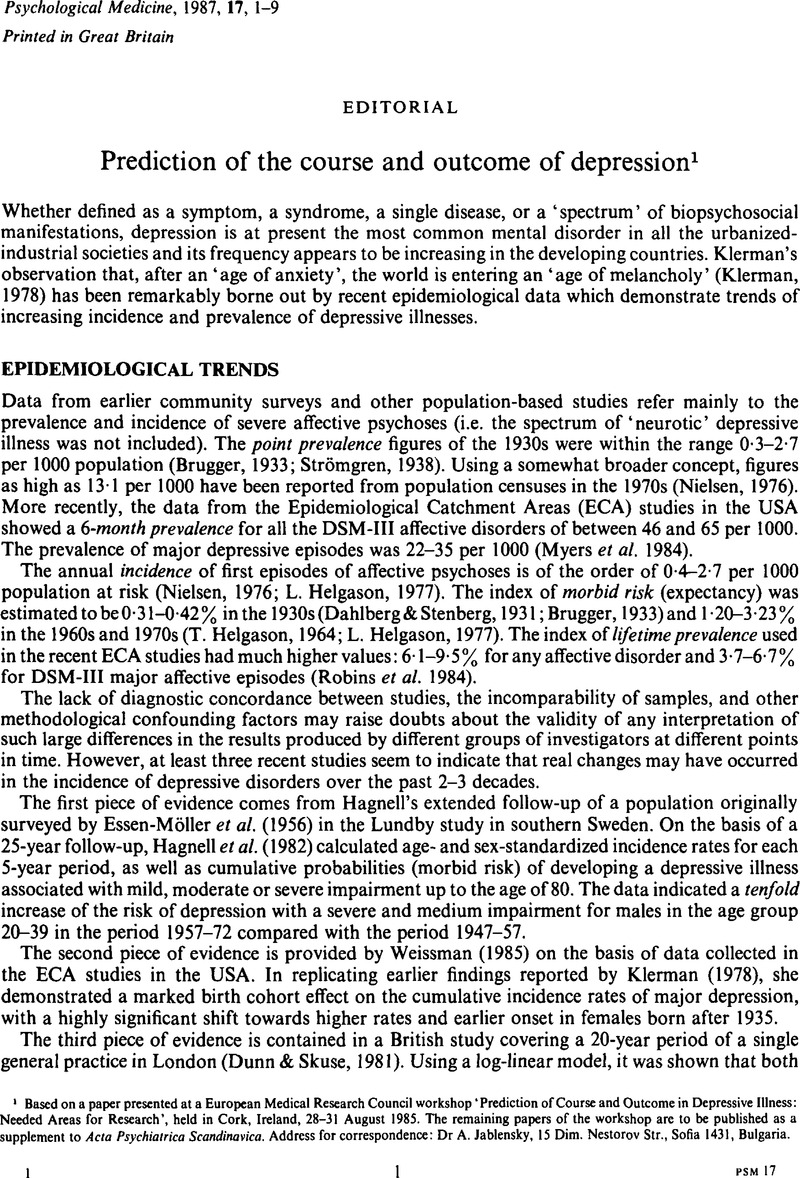Crossref Citations
This article has been cited by the following publications. This list is generated based on data provided by Crossref.
Bertschy, G.
Vandel, S.
and
Volmat, R.
1988.
Epidémiologie de la dépression: données récentes. II — Epidémiologie analytique et épidémiologie d’évaluation.
Psychiatry and Psychobiology,
Vol. 3,
Issue. 4,
p.
213.
Pinder, R. M.
1988.
The benefits and risks of antidepressant drugs.
Human Psychopharmacology: Clinical and Experimental,
Vol. 3,
Issue. 2,
p.
73.
Häfner, Heinz
1988.
What is schizophrenia?.
European archives of psychiatry and neurological sciences,
Vol. 238,
Issue. 2,
p.
63.
Jørgensen, P.
and
Aagaard, J.
1988.
Clinical predictors of course and outcome in delusional psychosis.
Acta Psychiatrica Scandinavica,
Vol. 77,
Issue. 3,
p.
332.
Wessely, S
1989.
Myalgic Encephalomyelitis — A Warning: Discussion Paper.
Journal of the Royal Society of Medicine,
Vol. 82,
Issue. 4,
p.
215.
Littlewood, Roland
1990.
From Categories to Contexts: A Decade of the ‘New Cross-Cultural Psychiatry’.
British Journal of Psychiatry,
Vol. 156,
Issue. 3,
p.
308.
Nierenberg, Andrew A.
Price, Lawrence H.
Charney, Dennis S.
and
Heninger, George R.
1990.
After lithium augmentation: a retrospective follow-up of patients with antidepressant-refractory depression.
Journal of Affective Disorders,
Vol. 18,
Issue. 3,
p.
167.
Häfner, H.
1990.
Search for the Causes of Schizophrenia.
p.
408.
Lerner, Y.
Wittman, L.
Zilber, N.
and
Barasch, M.
1991.
Long-term utilization of community mental health outpatient services in Jerusalem.
Social Psychiatry and Psychiatric Epidemiology,
Vol. 26,
Issue. 1,
p.
34.
Calarco, Margaret M.
and
Krone, Kathleen P.
1991.
An Integrated Nursing Model of Depressive Behavior in Adults.
Nursing Clinics of North America,
Vol. 26,
Issue. 3,
p.
573.
Baldwin, Bob
1991.
The outcome of depression in old age.
International Journal of Geriatric Psychiatry,
Vol. 6,
Issue. 6,
p.
395.
Häfner, H.
Riecher-Rössler, A.
Hambrecht, M.
Maurer, K.
Meissner, S.
Schmidtke, A.
Fätkenheuer, B.
Löffler, W.
and
van der Heiden, W.
1992.
IRAOS: an instrument for the assessment of onset and early course of schizophrenia.
Schizophrenia Research,
Vol. 6,
Issue. 3,
p.
209.
Paykel, E. S.
and
Priest, R. G.
1992.
Recognition and management of depression in general practice: consensus statement..
BMJ,
Vol. 305,
Issue. 6863,
p.
1198.
Angst, J.
1992.
Epidemiology of depression.
Psychopharmacology,
Vol. 106,
Issue. S1,
p.
S71.
Barker, Philip J.
1992.
Severe Depression.
p.
1.
Nicolaou, Stylianos
and
de Girolamo, Giovanni
1993.
Classificazione, diagnosi ed ICD-10. III - Le sindromi affettive.
Epidemiologia e Psichiatria Sociale,
Vol. 2,
Issue. 2,
p.
119.
Brodaty, Henry
Harris, Lynne
Peters, Karin
Wilhelm, Kay
Hickie, Ian
Boyce, Philip
Mitchell, Philip
Parker, Gordon
and
Eyers, Kerrie
1993.
Prognosis of Depression in the Elderly.
British Journal of Psychiatry,
Vol. 163,
Issue. 5,
p.
589.
Henry, John A.
1993.
Debits and Credits in the Management of Depression.
British Journal of Psychiatry,
Vol. 163,
Issue. S20,
p.
33.
Andrew, Bernice
Hawton, Keith
Fagg, Joan
and
Westbrook, David
1993.
Do Psychosocial Factors Influence Outcome in Severely Depressed Female Psychiatric In-patients?.
British Journal of Psychiatry,
Vol. 163,
Issue. 6,
p.
747.
Thornicroft, Graham
and
Sartorius, Norman
1993.
The course and outcome of depression in different cultures: 10-year follow-up of the WHO Collaborative Study on the Assessment of Depressive Disorders.
Psychological Medicine,
Vol. 23,
Issue. 4,
p.
1023.



